…like my Crazy Good Gluten-Free All-Purpose Blend
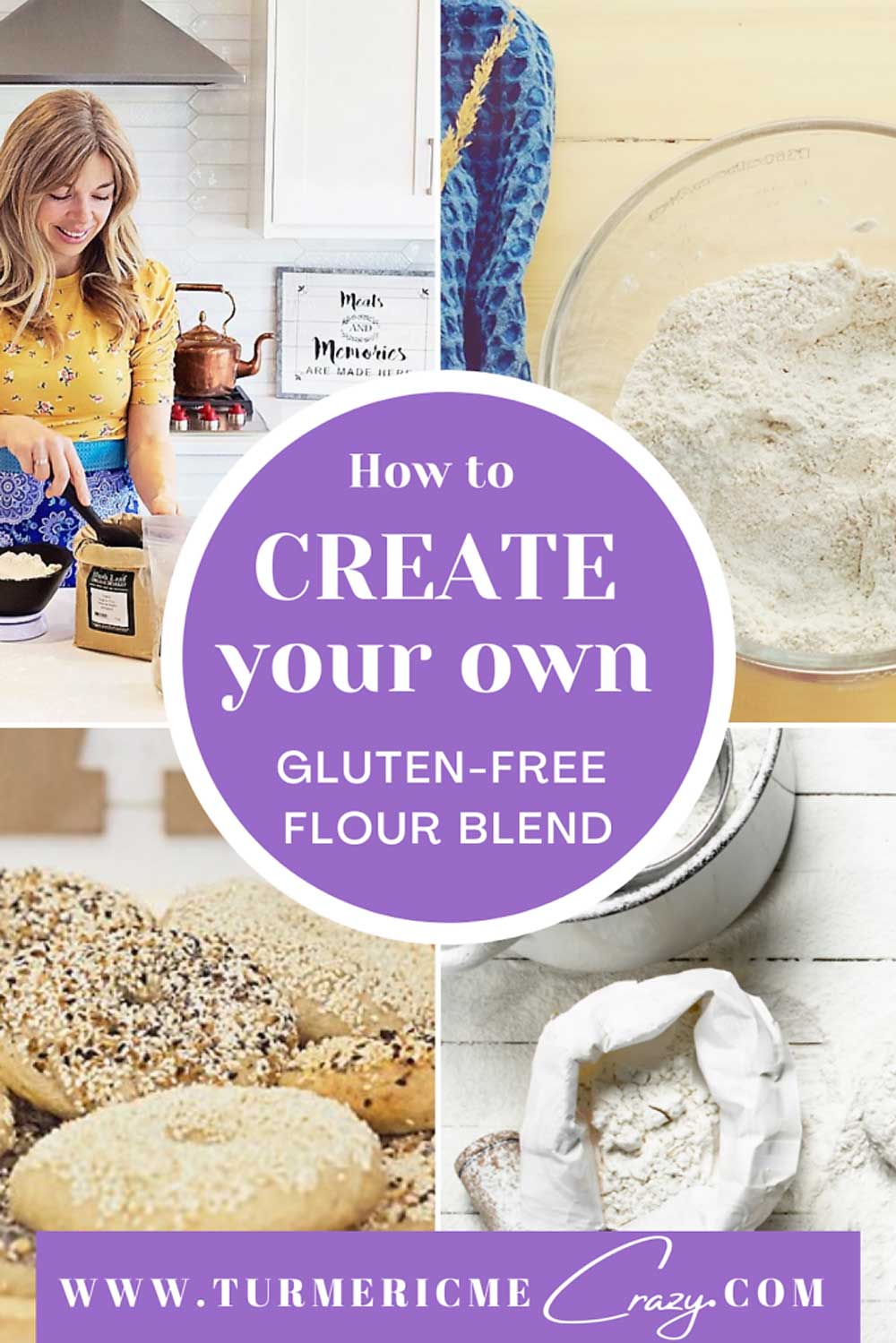
Welcome to my HOW TO GLUTEN-FREE SERIES – Part 2
Thank you ever so much for joining me for Part 2 of my How to Gluten-Free Series! Today we will dive into How to CREATE your own Gluten-Free Flour Blend. I hope to provide you with the skills to make your own blend as well as give you the details of how to make my Crazy Good Gluten-Free All-Purpose Flour, a great blend to use as a starting point, a substitute for All-Purpose Flour or for unlimited Gluten-Free baking recipes!
My sincere hope is that by creating this series, I can prevent you from experiencing some of the growing pains that I went through when switching to Gluten-Free! The goal is to give you as many tools as possible so that you may enjoy ALL of your family favourites again without worrying about the gluten content. I hope you’ll join me in my Canadian World Kitchen as we journey to Gluten-Free living together!
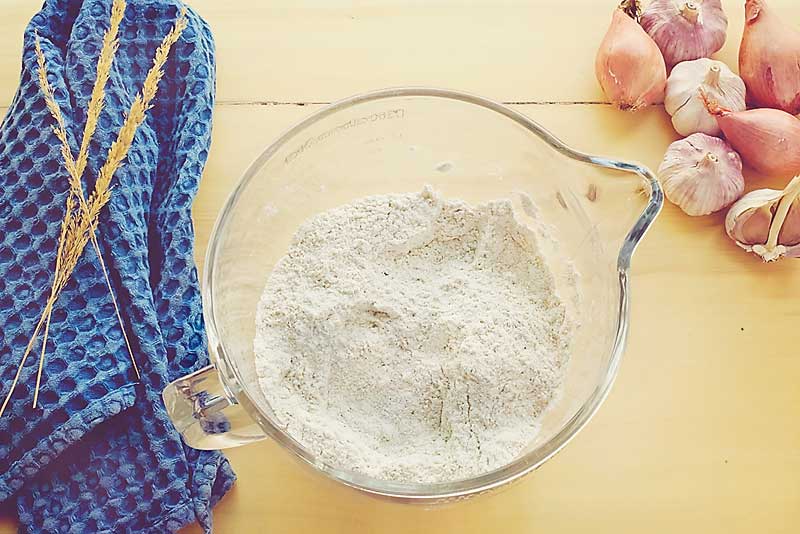
It’s easy, I PROMISE!
I promise it is SUPER easy to create your own Gluten-Free Blend! Please believe me when I say you’ll be SO very glad you did! With a lovely blend of Gluten-Free Flours & Starches you absolutely can create an endless list of incredible Gluten-Free dishes without anyone being the wiser! It requires only very simple math and a kitchen scale. Trust me, it is TOTALLY worth the investment as you’re going to love how easy it is to enjoy ALL of your family favourites! So let’s get straight to it shall we?
You’ll LOVE this post if:
- You miss your favourite family recipes & need help to make them Gluten-Free.
- You would like to cook for someone who is Gluten-Free.
- You’re looking for a fantastic recipe to make your own Gluten-Free Flour Blend.
- You want to find a fantastic but easy substitute for wheat flours in your recipes.
- All of this Gluten-Free stuff overwhelms you.
Contents (Jump AHEAD anytime)
- How to make Gluten Free Flours Mimic Wheat!
- My Crazy Good Gluten-Free All-Purpose Flour Blend with video
- How to calculate the WEIGHT of each Gluten-Free Flour & Starch (easy math I promise)
- Always ADD a BINDING AGENT to your Gluten-Free Flour Blend
- Frequently Asked Questions
How to make Gluten Free Flours Mimic Wheat!
Composition of Wheat Flours
Wheat flours contain 6-14% gluten protein. There are two main types of wheat flour categories, Hard & Soft Wheat. Hard Wheat is composed of large aggregate proteins (which means that the gluten containing proteins clump together) which make it harder for people like me to digest. Boohoo! Hard Wheat also is higher in gluten protein content which gives dough made with this flour its elasticity and strength. My allergist explained to me that most All-Purpose and Whole Wheat Grains grown in North America are of the hard wheat variety. Soft Wheat, on the other hand, have smaller aggregate proteins and give a finer more crumbly texture to baking. Cake / pastry flour are often made from this type of grain.
Why so much hard wheat?
Why is most wheat grown in Canada and the USA hard wheat you ask? Hard wheat is very drought tolerant, therefore farmers began planting this variety during the time of draught and have stuck to it as hard wheat is much hardier than soft wheat! Most wheat grown in Eastern Europe on the other hand is the soft wheat variety.

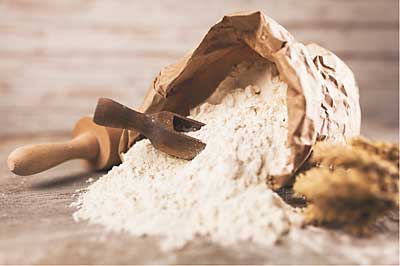
In addition, wheat flour is composed of a mixture of starches and whole grain proteins. In fact, between 60-70% of wheat flour content is starch! So it just makes perfect sense that your gluten-free flour should reflect this in its composition. Titli, from The Bread Kitchen explains this well in her video.
Composition of Gluten-Free Flour Blends
Like its’s wheat counterpart, each Gluten-Free Flour and Starch have unique properties and will behave differently when added to baking or any recipe. To replicate the effects of gluten, we need to find the right percentages of starchy, whole grain and protein rich Gluten-Free Flours. By doing so, we can alter the properties of a Gluten-Free Flour Blend quite significantly.
With all this in mind I created my Crazy Good Gluten-Free All-Purpose Flour Blend. I recommend you try this one 1st and see how it works for your recipe. Once you’re more comfortable, feel free to use my How To Choose the Right Gluten-Free Flour for ANY Recipe (coming soon) and create your own perfect blends! Have fun with it!
The beauty of having so many options for combinations of flours and starches is that you can be flexible based on what is available and your personal taste!
Good Rule to follow for % Whole-Grain : % Starches for an All-Purpose Blend
If you want to dive right in and try and make your own blend in the mean time, I recommend following this rule to create the a lovely but simple All-Purpose Blend:
60% Gluten-Free Starches (2-3 different starches) : 40% Whole Grain Flours (1-2 different flours) with at least 15% protein coming from both sources. A higher protein content works great too and will help give more structure to your dough if your recipe requires it!
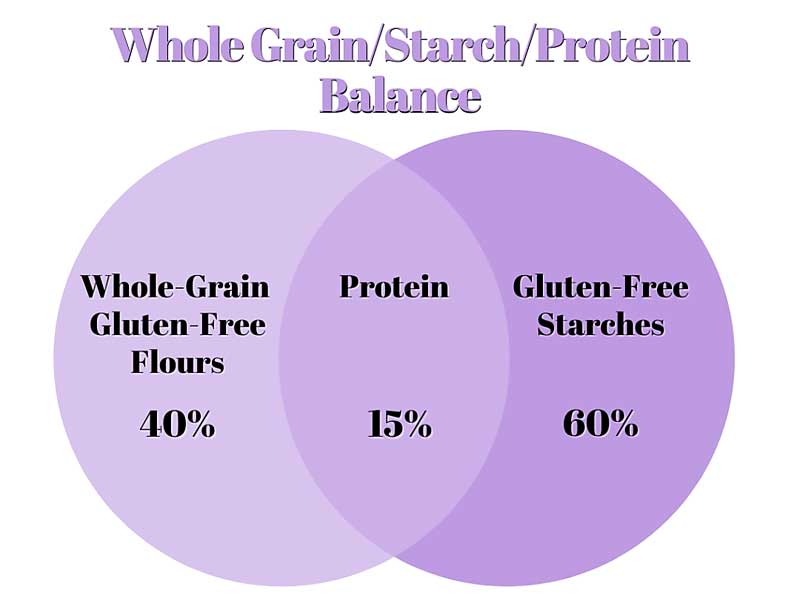
I created my Crazy Good Gluten-Free All-Purpose Blend with just these percentages in mind! It works best for replacing medium to large amounts of wheat flour in any recipe. If you are wanting to replace a small amount of wheat flour in a recipe, check out my post How to Make ANY Recipe Gluten-Free in 3-Simple Steps! There you’ll find How to make any SAVOURY recipe Gluten-Free in 1-Simple Step which will walk you through how to do just that!
What about a Whole Grain Blend?
When substituting for whole-wheat flour, try using a ratio of 70% grain flours to 30% starches. This proportion will give you a gorgeous whole grain blend.
Every baker has their own favourite blends that all have different ratios of whole grains : starches. Once you feel more comfortable and have a good stock in your pantry, play around with your ratios so you can find out what works the best for each of your special recipes!
My Crazy Good Gluten-Free All-Purpose Flour Blend
Check out this 40 sec how to video:
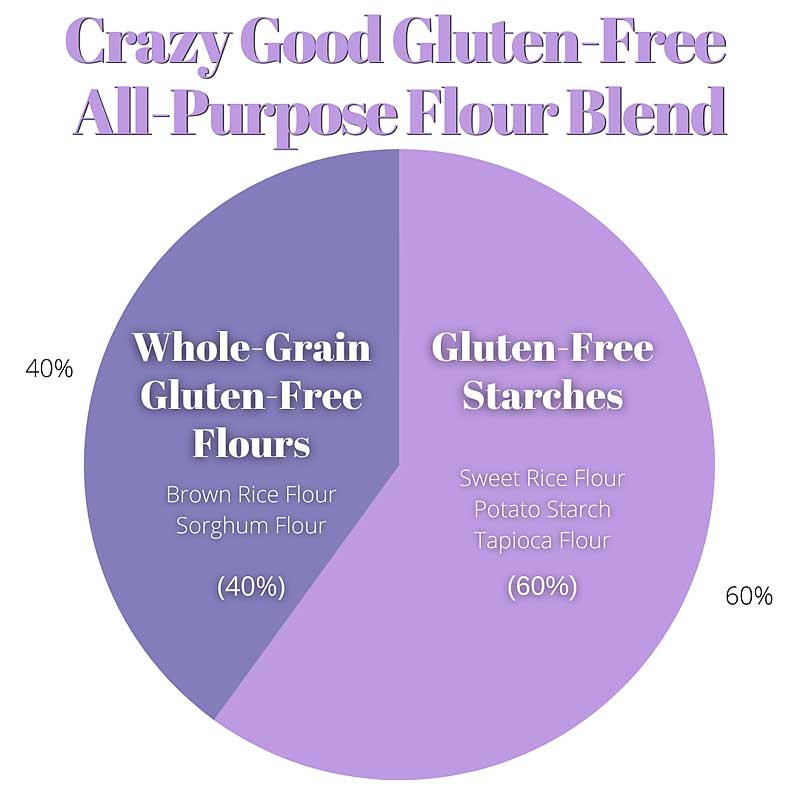
Ingredients in my Crazy Good Gluten-Free All-Purpose Flour Blend
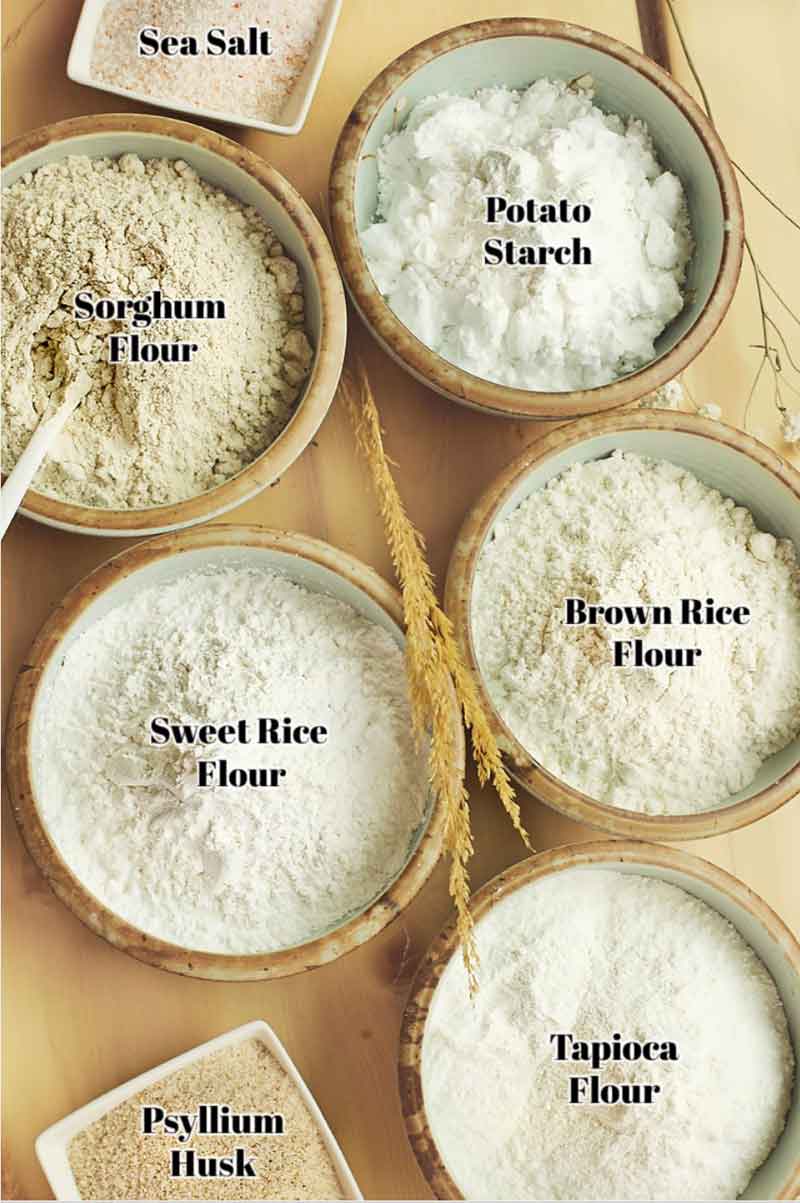
STARCHY FLOURS
- SWEET RICE FLOUR:
- Sweet Rice Flour is not the same thing as White Rice Flour. The only similarity they have is that they are both made from rice, albeit totally different types of rice. You can NOT substitute, as sadly they are not interchangeable.
- Sweet Rice Flour is made from glutinous (sticky glue like texture- not made from gluten!) rice & white rice is made from long and short grain white rice. Some even call it an indispensable ingredient in your gluten free kitchen! I couldn’t agree more! Sweet Rice Flour mimics gluten in gluten breads by giving the dough it’s stretchy, pliable properties. Georgina has a wonderful post “The Ultimate Guide to Sweet Rice Flour” here where she explains in beautiful detail why it’s such a powerhouse in gluten free baking.
- Where to find it? Sweet rice flour is readily found in Asian supermarkets, like TnT in Calgary, or in the Asian aisle of the supermarkets. It can be labelled ‘glutinous rice flour’ or ‘mochiko flour’. But be sure to check the label as they are not always certified gluten-free. I prefer to use flours like Bob’s Red Mill Sweet Rice Flour which you can find at many local grocery stores & organic markets like Blush Lane Organic Market here in Calgary where you can find my favourite brand by Blush Lane Organics.
COMMON GLUTEN FREE STARCHES
- POTATO STARCH:
- Potato Starch is a starchy flour that helps bind and hold the bagels together. However, Potato Starch is NOT the same thing as Potato Flour. Potato starch is a natural way to increase the moisture of the dough as potato starch absorbs and holds liquid.
- You know when you soak potatoes before baking so that they are more crispy? Well, that’s kind of how potato starch is made. Crushed potatoes are soaked in water, then the starch that comes out of the water is dried and becomes the white starch known as Potato Starch. Potato Flour, on the other hand, is created by using the entire potato which is cooked, dried and then ground.
- You can find Potato Starch at most grocery stores in the organic/natural foods aisle. I use Bob’s Red Mill.
- TAPIOCA FLOUR (AKA TAPIOCA STARCH):
- Like other starches, Tapioca Flour (aka Tapioca starch) is a very fine white powder that comes from the pulp of the cassava plant. It is not the same thing as cassava flour however, which is made from the entire root of the cassava plant.
- It is used to help create the chewy texture and crispy crust in our Momma’s Marvellous Montreal Style Bagels.
- Where to find it? You can find Tapioca Flour at most grocery stores in the organic/natural foods aisle.
WHOLE GRAIN FLOURS
- BROWN RICE FLOUR:
- Brown Rice Flour is made by finely grinding short grain brown rice. I like Bob’s Red Mill Brown Rice Flour as it is stone ground to a very fine texture. It lends a nice light fluffiness and slightly nutty flavour to our bagels.
- Where to find it? You can find Bob’s Red Mill Brown Rice Flour at most grocery stores in the organic/natural foods aisle. To make this flour superfine, I simply blend it in my high speed blender. It does the trick!
- SORGHUM FLOUR:
- Sorghum Flour is unrelated to wheat and totally gluten free! It has a mild taste & smooth texture making it an excellent flour for breads.
- Sorghum flour originated in Africa and is still used in Indian & African cooking such as Jowar Roti (flat breads made with Sorghum Flour).
- Where to find it? I buy my Sorghum Flour at Blush Lane Organics in Calgary, but you can also find it at most grocery stores in the organic/natural foods aisle.
BINDERS
- PSYLLIUM HUSK:
- Psyllium Husk is one of the KEY ingredients to making this Gluten-Free All-Purpose Flour so versatile! Please see my post What are BINDING AGENTS and How to USE them for more details on this incredible mix!
How to choose the amounts of each of the Whole-Grain Flours & Starches
With experience and simply playing around and getting to know each of the different Gluten-Free Whole-Grain and Starches, you’ll start to recognize the different properties each one imparts.
To start off you can simply split the percentage into equal parts if you want to experiment. Or you can follow the percentages I’ve chosen based on my experience. For example:
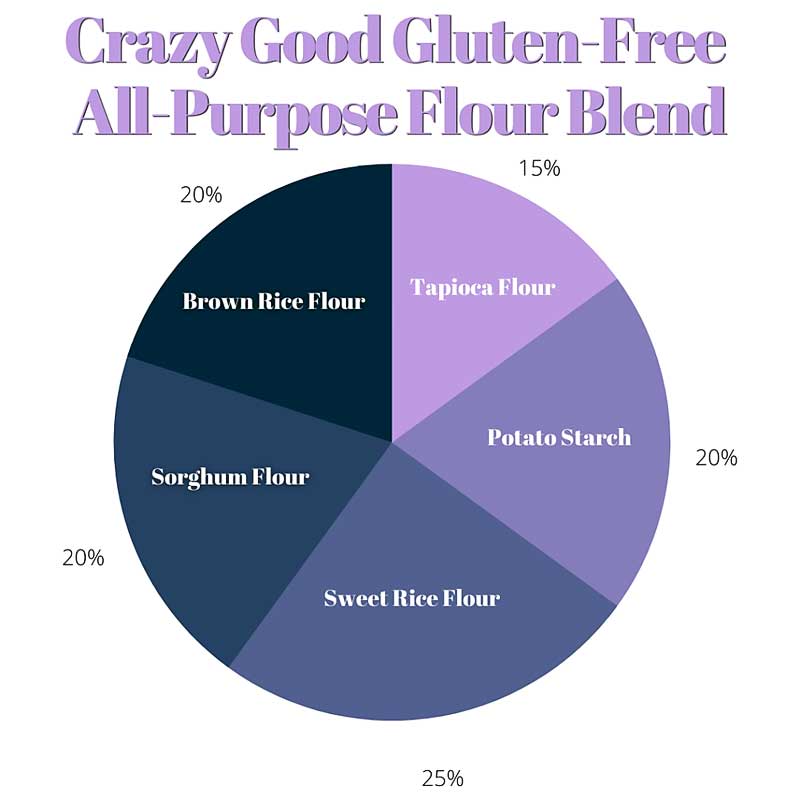
As the saying goes, Rome wasn’t built in a day, and it will take time for you to figure out the perfect balance of each grain and starch for each of your different recipes. I plan to create many more posts of my favourite blends to use for different purposes, but my Crazy Good Gluten-Free All-Purpose Flour is a great starting point fo you to get going!
How to Calculate WEIGHT of each Gluten-Free Flour & Starch to Create your own Gluten-Free Flour
(easy math I promise)
1) Decide what type of Gluten-Free Flours & Starch will you use?
2) Calculate weight via percentages of each flour:
For example, applying the 60% Gluten-Free Starches : 40% Whole Grain Flours rule to our Banana Muffins Recipe:
Total Weight Regular AP Flour in recipe = 420 g
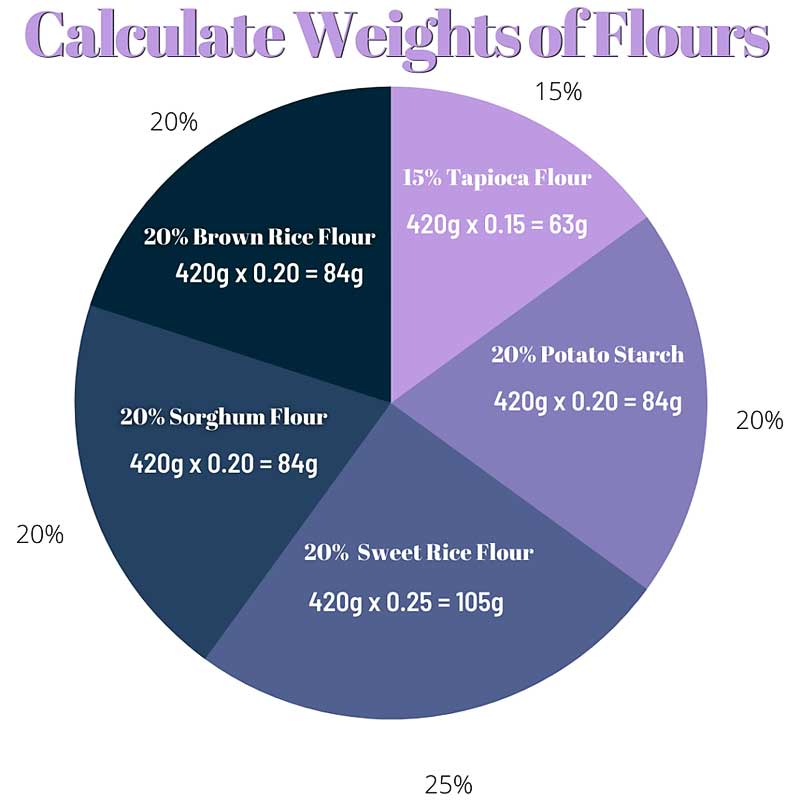
NOTE: You can also make my Crazy Good Gluten-Free All-Purpose Flour in a large batch (See recipe below).
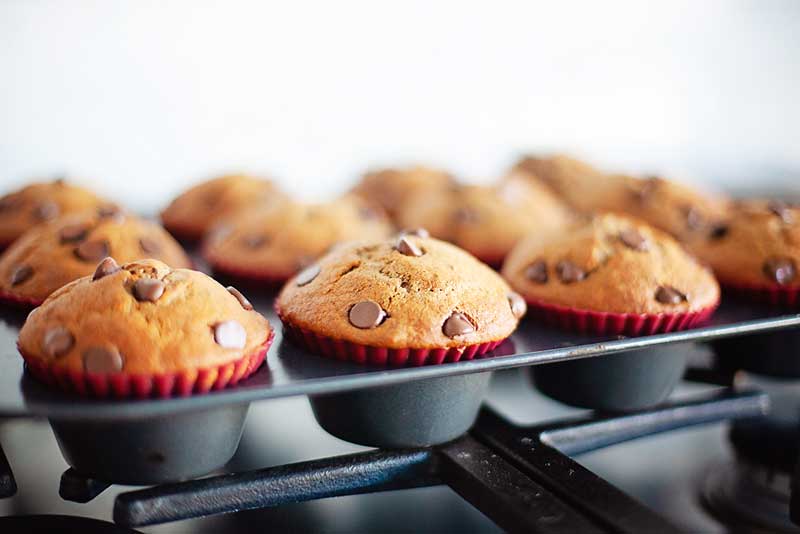
3) Weigh out each Flour & Starch & SIFT them together!
It’s as simple as that! Now you can use your lovely home made Gluten-Free Flour Blend to make ANY baking recipe Gluten-Free! See my post here on how to do just that! If you need a little CHEET SHEET to reference now and then, I’ve created 2 to help you out.
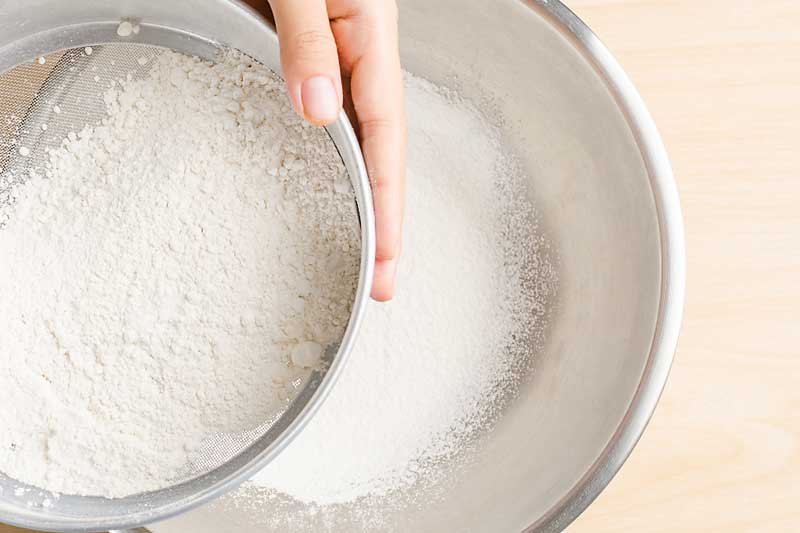
Always add a BINDING AGENT to your Gluten-Free Flour Blend!
ALWAYS make sure to use a BINDING AGENT to help mimic Gluten! I never add the binder to my Gluten-Free Flour Blend until I’m about to use it. WHY you ask? I’ve found that different BINDERS work better for different purposes. Adding your binder when you are ready to bake allows you the freedom to chose which one is best for each of your recipes!
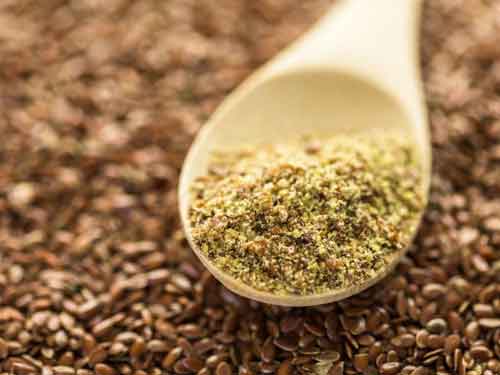
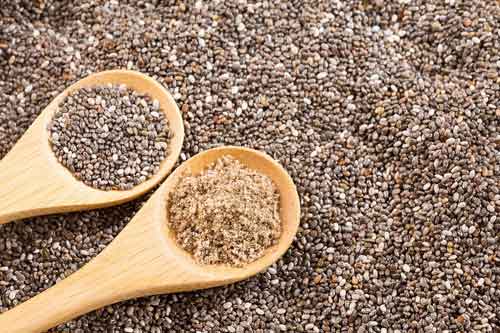
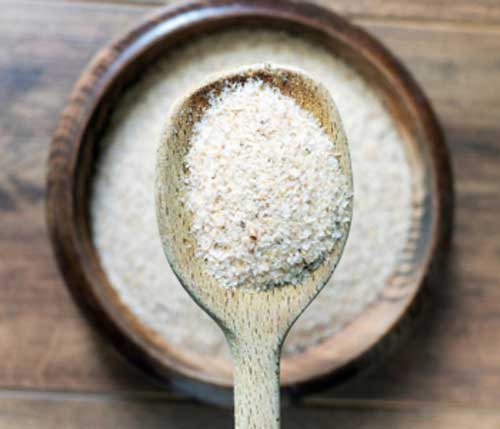
See my post How to make almost ANY recipe Gluten-Free in 3-Simple Steps AND my post on What are BINDING AGENTS & how to use them in Gluten-Free Cooking to find out more about BINDING AGENTS and how to use them!
PIN THIS HOW TO CREATE A GLUTEN FREE FLOUR BLEND
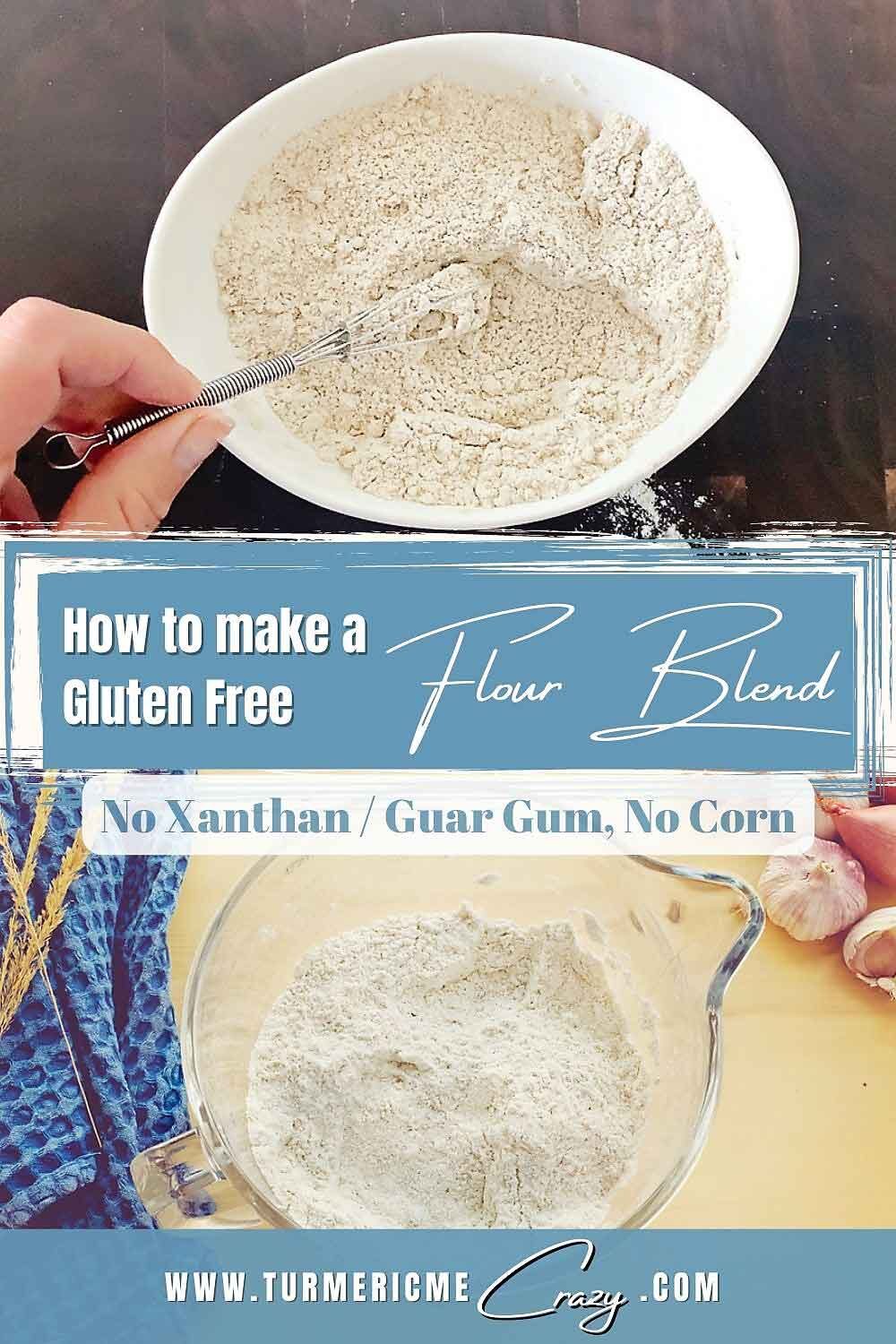
Frequently Asked Questions
Do I really need to weigh the ingredients?
Yes! I have learn’t through experience that weighing ingredients using a scale whilst baking is super important and will allow you to reproduce great results every time! I’ve attempted measuring out the flours by volume (e.g. cups), then double checked the weights of each. They were off by quite a lot actually! It can mean the difference between the most incredible and beautiful looking bagel, to one that quite literally flops. The density of the ingredient makes a BIG difference in the volume of the flour. A new bag of flour may be packed down tight vs an already opened one. A gram will always be a gram of flour!
A KITCHEN SCALE IS WORTH THE INVESTMENT!
I use a very simple mini digital kitchen scale that I got for $19.99. Trust me it is well worth the investment! It is super easy to measure ingredients by weight. I think it’s WAY easier than measuring by volume (e.g. cups). To measure flour, place a bowl on the scale, press the tare button to zero your scale to the weight of the bowl, and then add your flour. Simple as that!
But what if I’m allergic to one of the flours in this blend? Can I substitute?
I am currently working on a post where I will share my favourite Gluten-Free flours and help you uncover the mystery of it all! That way if you’d like to experiment with different gluten free flours and starches you have laying around you can! Or if you have an intolerance to one of the flours I use in this recipe, you’ll be able to calculate exact ratios of a substitute flour or starch. Not all Gluten-Free Starches and Flours have the same flavours, protein content etc. So it’s best to do a little digging before you substitute so you are not disappointed. Or check out my post when it’s ready!
But how did you decide on the ratios of each flour?
Each of the flours and starches I used in this recipe have different properties, flavours and bring something different to your bake. With practice, you’ll be able to play around with the different percentages of each of the whole grain and starches that make up the 60:40 ratio (starches : whole grains).
Why can’t I use just one type of Gluten-Free Flour? Why a BLEND?
If you try and use simply one Gluten-Free Flour without a binder, you’ll sadly be quite disappointed. Trust me, I’ve tried! There’s no one flour or binder that can do it all! Georgina, from “The Larder” explains if we use just one we may find:
- Sweet rice flour – too stodgy
- White rice flour – too grainy
- Coconut flour – too dry
- Oat flour – too crumbly
- Almond flour – too dense
I have found that using one flour just doesn’t mimic the properties of gluten nearly enough to have success. Therefore, a combination of flours and starches that mimic gluten as closely as possible are preferred.

ENJOY!
I am just so excited to share this How to Gluten-Free Series with you all! My hope is that this series will help make your cooking and baking experience easier in some way. From my Canadian World Kitchen to your World Kitchen, where ever you call home, I wish you much love in your journey.
If you’ve enjoyed this series so far, please share it with your loved ones or better yet, PIN it to your Pinterest page. I’d love it if you followed me with the links below.
Much love and hugs,


Crazy Good Gluten Free All-Purpose Flour Blend
Equipment Needed
INGREDIENTS
- 250 g Sweet Rice Flour (aka Glutinous or sticky rice flour)
- 200 g Potato Starch I use Bob's Red Mill brand
- 150 g Tapioca Flour (aka Tapioca Starch) I use Bob's Red Mill brand
- 200 g Brown Rice Flour I use Bob's Red Mill brand
- 200 g Sorghum Flour I use Blush Lane Organics brand
INSTRUCTIONS
- Weigh out individual Flours & Starches.
- Sift together.
- *Store in an air-tight container & use within 3 months.
- **When ready to bake, make sure to ADD a BINDER & KEY ingredients!

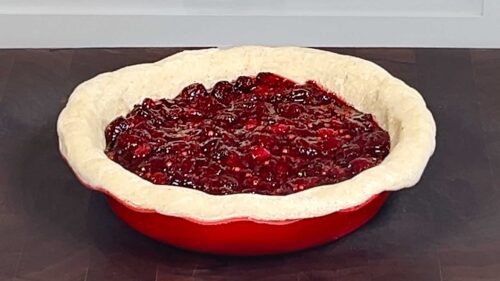

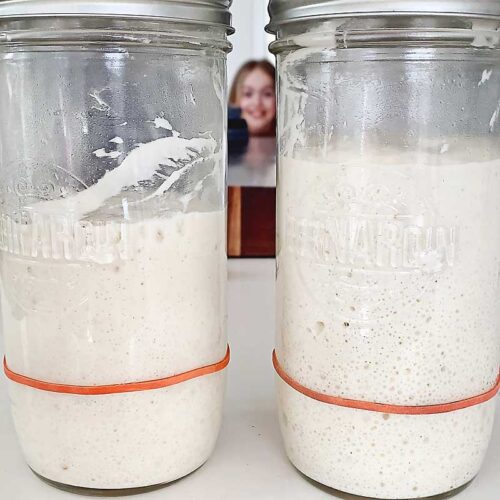
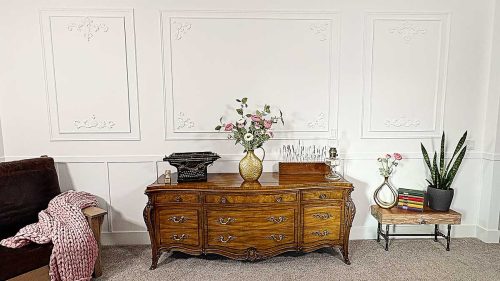
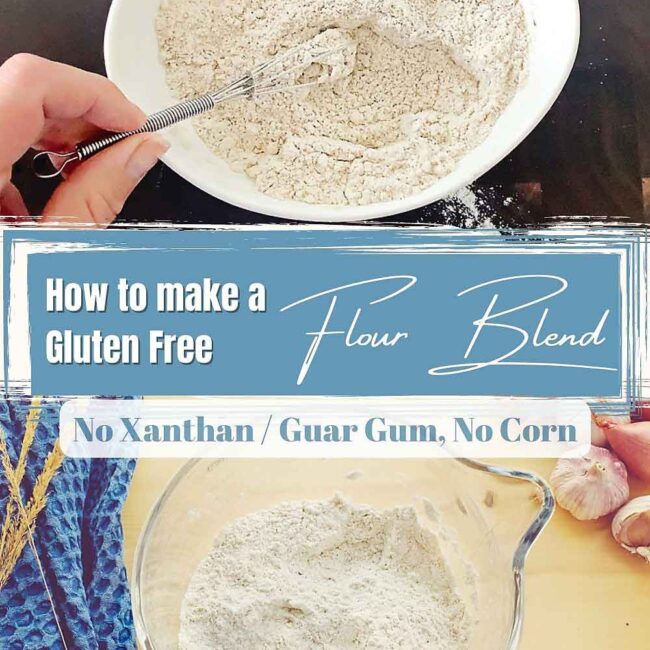
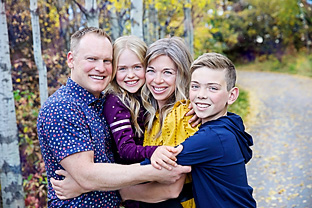


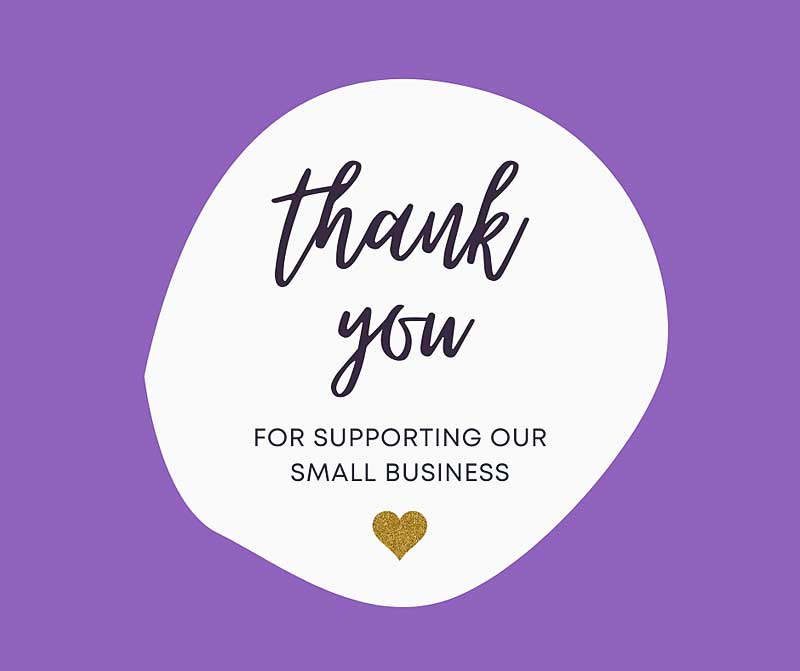
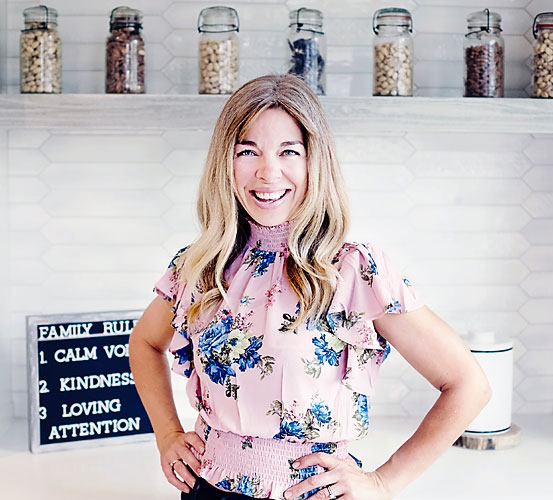
2 Responses
Thank you Trish,
Were going to make some dough this weekend. We appreciate your recommendations on brands as there are so many options and you have not steered us off course yet. I’ll PM you how things worked out.
Jim & Ceclie
You are very welcome Jim! I’m so happy you find the tips helpful.